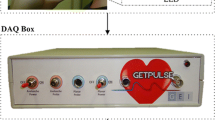Abstract
Traditional Chinese Medicine (TCM) is based on five main types of diagnoses methods consisting of inspection, auscultation, olfaction, inquiry, and palpation. The most important one is palpation also called pulse diagnosis which is to measure wrist artery pulse by doctor’s fingers for detecting patient’s health state. In this paper, it is carried out by using a specialized pulse measuring instrument to classify one’s pulse type. The measured pulse waves (MPWs) were segmented into the arterial pulse wave curve (APWC) by image proposing method. The slopes and periods among four specific points on the APWC were taken to be the pulse features. Three algorithms are proposed in this paper, which could extract these features from the APWCs and compared their differences between each of them to the average feature matrix, individually. These results show that the method proposed in this study is superior and more accurate than the previous studies. The proposed method could significantly save doctors a large amount of time, increase accuracy and decrease data volume.















Similar content being viewed by others
References
Hong, Z.H., Pulse diagnosis: the unique medical diagnostic methods. Lide, Taipei, 1992.
Huang, J.M., Modern pulse diagnosis and pulse graphics. Salon, Taipei, 2007.
Wang, H., and Cheng, Y., “A Quantitative System for Pulse Diagnosis in Traditional Chinese Medicine,” Proceedings of the 27-th Annual Conference on Engineering in Medicine and Biology, pp. 5676–5679, Shanghai, China, 17–18 Jan. 2006.
Wang, B., Guo, H., Zheng, S., and Yang, X., “TCM Pulse-Condition Classification Method Based on BP Neural Network,” Proceedings of first International Conference on Bioinformatics and Biomedical Engineering, pp. 629–632, 2007.
Yang, Y.L., and Chang, H.H., The study of radial sphygmogram in patients with heart failure. J. Chin. Med. 17(3):85–94, 2006.
Ogiela, L., Computational intelligence in cognitive healthcare information systems. Stud. Comput. Intell. 309:347–369, 2010.
Huang, C.M., Wei, C.C., Liao, Y.T., Chang, H.C., Kao, S.T., and Li, T.C., Developing the effective method of spectral harmonic energy ratio to analyze the arterial pulse spectrum. Evid. Based Complement. Alternat. Med. 2011:Article ID 342462 , 2011.7 pages
Wang, C.A., Chen, H.C., and Chen, Y.L., A method using image processing technique to automatically extract the specific arterial pulse wave pattern . Asia University, Taiwan, 2010.Master Thesis
Zhang, D., Zhang, L., Zhang, D., and Zheng, Y., “Wavelet based analysis of doppler ultrasonic wrist-pulse signals,” Proceedings of International Conference on BioMedical Engineering and Informatics, pp. 539–543, 2008.
Xia, C., Liu, R., Wang, Y., Yan, H., and Gewiss, H., “Wrist Pulse Analysis Based on RP and RQA,” Proceedings of 2nd International Conference on Biomedical Engineering and Informatics, pp. 1–5, 2009.
Yoon, Y.Z., Lee, M.H., and Soh, K.S., Pulse type classification by varying contact pressure. IEEE Eng. Med. Biol. Mag. 19(6):106–110, 2000.
Lu, W.A., Lin Wang, Y.Y., and Wang, W.K., Pulse analysis of patients with severe liver problems. Studying pulse spectrums to determine the effects on other organs. IEEE Eng. Med. Biol. Mag. 18(1):73–75, 1999.
Wu, S. C., Chen, H. S., Liou, C. C., Jhong, H. M., and Liou, M. C., “The Study of Optimal Amount Pacemaker Pulse Wave Localization by Using the Homemade the Measuring Instrument of Pulse Wave Conduction Velocity,” National Symposium on Telecommunications, 2007.
Wei, C.C., Huang, C.M., and Liao, Y.T., The exponential decay characteristic of the spectral distribution of blood pressure wave in radial artery. Comput. Biol. Med. 39(5):453–459, 2009.
Hachaj, T., and Ogiela, M.R., CAD system for automatic analysis of CT perfusion maps. Opto-Electron. Rev. 19(1):95–103, 2011.
Ogiela, L., and Ogiela, M.R., Cognitive systems and bio-inspired computing in homeland security. J. Netw. Comput. Appl. 38:34–42, 2014.
Ogiela, M.R., and Bodzioch, S., Computer analysis of gallbladder ultrasonic images towards recognition of pathological lesions. Opto-Electron. Rev. 19(2):155–168, 2011.
Acknowledgments
This work was supported by the Ministry of Science and Technology (MOST), Taiwan, Republic of China, under Grant MOST 104-2221-E-468-002.
Author information
Authors and Affiliations
Corresponding author
Additional information
This article is part of the Topical Collection on Systems-Level Quality Improvement
Rights and permissions
About this article
Cite this article
Chen, HC., Kuo, SS., Sun, SC. et al. A Distinguishing Arterial Pulse Waves Approach by Using Image Processing and Feature Extraction Technique. J Med Syst 40, 215 (2016). https://doi.org/10.1007/s10916-016-0568-4
Received:
Accepted:
Published:
DOI: https://doi.org/10.1007/s10916-016-0568-4




